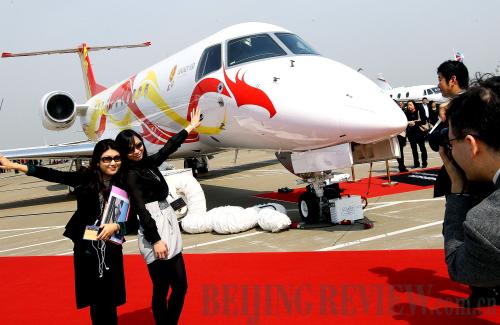 |
|
READY TO FLY: Visitors to the Asian Business Aviation Conference and Exhibition in Shanghai in March pose for photos in front of a business jet on display (CHEN FEI) |
"My jet always flies illegally at the risk of a heavy fine," an anonymous owner of a luxury hotel in Shenzhen told Guangzhou Daily. The convenience of having one's own jet has yet to materialize in the Chinese mainland due to strict aerospace control. According to current laws and regulations, before every flight of a private jet, an application must be filed to local civil aviation authorities at least one week in advance. Even for emergency flights, application time must be at least three days before the flight. After civil aviation administrators ratify the application, it has to be submitted to the Air Force.
"The application, even going through a smooth process, will cost me about 10 days. I often impulsively decide to fly to a business meeting in the morning and to a beach resort for leisure in the afternoon. It is unrealistic for me to apply for each flight," said the anonymous entrepreneur, whose son is a licensed pilot.
Besides regulatory barriers, the lack of infrastructure has also greatly dampened the enthusiasm of wealthy people in purchasing their own aircraft. China had merely 286 airports and temporary landing strips available by 2011, far fewer than the 15,000 in the United States, according to the Civil Aviation Administration of China (CAAC).
In the Chinese mainland, regulations demand that all private aircraft should be kept and maintained at hangars of certified companies while the cost started at nearly 1 million yuan ($157,426) annually for smaller aircraft models.
However, the strict control of aerospace by military and civil aviation regulators, which has for decades stifled the general aviation market of China, is easing. The process started in November 2010 when China announced a reform over the administration of the country's low-altitude airspace, defined as below 1,000 meters.
China's low-altitude airspace has been controlled by the Air Force and the CAAC.
Starting from January this year, airspace below 1,000 meters in northeast, central and south China, as well as six pilot cities, opened to general aviation on a trial basis. The six pilot cities are Tangshan in northern Hebei Province, Xi'an in northwestern Shaanxi Province, Qingdao in eastern Shandong Province, Hangzhou and Ningbo in eastern Zhejiang Province and Kunming.
General aviation refers to all flights other than military and scheduled airline passenger and cargo flights, including private flying activities, flight training, air ambulance, police aviation, aerial firefighting, air charter, bush flying, gliding and skydiving. China's general aviation hours flown totaled 502,700 in 2011, an increase of 28.5 percent year on year.
The area of low-altitude airspace in regions and cities open to general aviation flights accounted for 31.6 percent of that for China's total land territory.
Li Jiaxiang, Director of CAAC, said in March that China will fully open its low-altitude airspace to general aviation in 2015 and the country is also going to build 72 new airports, for regional aircraft and private jets, mainly in the country's west, by 2015.
China aims at a 19-percent annual growth in general aviation air traffic from 502,700 flying hours in 2011 to 2 million by 2020, according to a development program for the civil aviation sector released by the State Council, China's cabinet, on July 12.
China will further relax the ban on low-altitude airspace for private use and would also increase the number of cities and facilities available for general aviation, said Huang Min, Director General of the Department of Basic Industries of the National Development and Reform Commission, at a press conference on July 20. The commission is in charge of coordinating government departments to achieve airspace reform.
Email us at: lili@bjreview.com | 